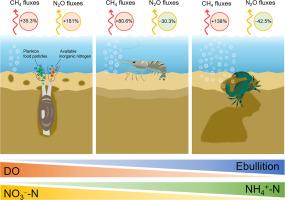当前位置:
X-MOL 学术
›
Water Res.
›
论文详情
Our official English website, www.x-mol.net, welcomes your
feedback! (Note: you will need to create a separate account there.)
Divergent impacts of animal bioturbation on methane and nitrous oxide emissions from mariculture ponds
Water Research ( IF 11.4 ) Pub Date : 2024-11-19 , DOI: 10.1016/j.watres.2024.122822 Yanhong Dong, Junji Yuan, Junjie Li, Deyan Liu, Xian Wu, Huijie Zheng, Hui Wang, Huiqin Wang, Weixin Ding
Water Research ( IF 11.4 ) Pub Date : 2024-11-19 , DOI: 10.1016/j.watres.2024.122822 Yanhong Dong, Junji Yuan, Junjie Li, Deyan Liu, Xian Wu, Huijie Zheng, Hui Wang, Huiqin Wang, Weixin Ding

|
Aquaculture systems are of increasing concern as an important source of atmospheric methane (CH4) and nitrous oxide (N2O). However, the role of animals in regulating CH4 and N2O emissions from aquaculture systems remains unclear. Here, we established mesocosm trials to investigate impacts of bioturbation of different aquaculture species (i.e., clam, shrimp, and crab) on CH4 and N2O fluxes in a mariculture pond. Across the initial, middle, and final culturing stages, mean CH4 flux in mesocosm without animals was 4.81 ± 0.09 µg CH4 m‒2 h‒1, while the existence of clam, shrimp, and crab significantly increased CH4 flux by 35.3%, 80.6%, and 138%, respectively. Bioturbation significantly decreased dissolved oxygen (DO) concentration by 5.19‒44.8% but increased porewater CH4 concentration by 14.1‒59.9%, indicating that lowered DO caused by animal respiration promoted CH4 production in sediment. Moreover, bioturbation of animals significantly increased ebullitive CH4 fluxes by 41.0‒216%, contributing 57.4‒77.2% of the increased CH4 emission in mesocosms with animals. However, shrimp and crab significantly reduced N2O flux by 30.3% and 42.5%, respectively, primarily due to lowered DO conditions suppressing nitrification and limiting NO3‒ supply for denitrification. By contrast, clam significantly increased N2O emission by 181% because its filter-feeding behavior excreted more NH4+ and NO3‒ into overlying water and thereby facilitating N2O production. The N2O concentration in overlying water was 1.72‒2.83-fold of that in porewater, and the calculated diffusive N2O flux was 1.80‒37.5% greater than chamber-measured N2O efflux. This implied that N2O might be primarily produced in overlying water rather than sediments, and the produced N2O can either evade as water-air fluxes or diffuse downwards into sediments to be consumed. Overall, our study advocates that aquaculture-related climate mitigation strategies should place more attention on the divergent impacts of animal bioturbation on CH4 and N2O emissions.
中文翻译:

动物生物扰动对海水养殖池塘甲烷和一氧化二氮排放的不同影响
水产养殖系统作为大气中甲烷 (CH4) 和一氧化二氮 (N2O) 的重要来源,越来越受到关注。然而,动物在调节水产养殖系统排放 CH4 和 N2O 方面的作用仍不清楚。在这里,我们建立了中宇宙试验,以研究不同水产养殖物种(即蛤蜊、虾和螃蟹)的生物扰动对海水养殖池塘中 CH4 和 N2O 通量的影响。在初始、中期和最终培养阶段,无动物的中层平均 CH4 通量为 4.81 ± 0.09 μg CH4 m\u20122 h\u20121,而蛤蜊、虾和蟹的存在显著增加了 CH4 通量 35.3%、80.6% 和 138%。生物扰动显著降低了溶解氧 (DO) 浓度 5.19-44.8%,但孔隙水 CH4 浓度增加了 14.1-59.9%,表明动物呼吸引起的 DO 降低促进了沉积物中 CH4 的产生。此外,动物的生物扰动显著增加了 CH4 的沸腾通量 41.0\u201216%,占动物中宇宙中 CH4 发射增加的 57.4-77.2%。然而,虾和蟹分别显著降低了 N2O 通量 30.3% 和 42.5%,这主要是由于 DO 条件降低抑制了硝化作用并限制了 NO3\u2012 用于反硝化的供应。相比之下,蛤蜊的 N2O 排放量显著增加了 181%,因为它的滤食行为将更多的 NH4+ 和 NO3\u2012 排泄到上覆水中,从而促进了 N2O 的产生。上覆水中的 N2O 浓度为 1.72\u20122。孔隙水中的83倍,计算出的扩散N2O通量比腔室测量的N2O外排高1.80-37.5%。这意味着 N2O 可能主要在上覆水中产生,而不是在沉积物中产生,产生的 N2O 可以以水-空气通量的形式逃逸,也可以向下扩散到沉积物中以供食用。总体而言,我们的研究主张与水产养殖相关的气候缓解策略应更多地关注动物生物扰动对 CH4 和 N2O 排放的不同影响。
更新日期:2024-11-20
中文翻译:

动物生物扰动对海水养殖池塘甲烷和一氧化二氮排放的不同影响
水产养殖系统作为大气中甲烷 (CH4) 和一氧化二氮 (N2O) 的重要来源,越来越受到关注。然而,动物在调节水产养殖系统排放 CH4 和 N2O 方面的作用仍不清楚。在这里,我们建立了中宇宙试验,以研究不同水产养殖物种(即蛤蜊、虾和螃蟹)的生物扰动对海水养殖池塘中 CH4 和 N2O 通量的影响。在初始、中期和最终培养阶段,无动物的中层平均 CH4 通量为 4.81 ± 0.09 μg CH4 m\u20122 h\u20121,而蛤蜊、虾和蟹的存在显著增加了 CH4 通量 35.3%、80.6% 和 138%。生物扰动显著降低了溶解氧 (DO) 浓度 5.19-44.8%,但孔隙水 CH4 浓度增加了 14.1-59.9%,表明动物呼吸引起的 DO 降低促进了沉积物中 CH4 的产生。此外,动物的生物扰动显著增加了 CH4 的沸腾通量 41.0\u201216%,占动物中宇宙中 CH4 发射增加的 57.4-77.2%。然而,虾和蟹分别显著降低了 N2O 通量 30.3% 和 42.5%,这主要是由于 DO 条件降低抑制了硝化作用并限制了 NO3\u2012 用于反硝化的供应。相比之下,蛤蜊的 N2O 排放量显著增加了 181%,因为它的滤食行为将更多的 NH4+ 和 NO3\u2012 排泄到上覆水中,从而促进了 N2O 的产生。上覆水中的 N2O 浓度为 1.72\u20122。孔隙水中的83倍,计算出的扩散N2O通量比腔室测量的N2O外排高1.80-37.5%。这意味着 N2O 可能主要在上覆水中产生,而不是在沉积物中产生,产生的 N2O 可以以水-空气通量的形式逃逸,也可以向下扩散到沉积物中以供食用。总体而言,我们的研究主张与水产养殖相关的气候缓解策略应更多地关注动物生物扰动对 CH4 和 N2O 排放的不同影响。


















































 京公网安备 11010802027423号
京公网安备 11010802027423号